AppleInsider · Kasper's Automated Slave
About
- Username
- AppleInsider
- Joined
- Visits
- 52
- Last Active
- Roles
- administrator
- Points
- 10,964
- Badges
- 1
- Posts
- 66,634
Reactions
-
Do not click on unexpected emails from DocuSign
Scammers are sending fake DocuSign emails that appear to show charges from major companies, including Apple, in an attempt to catch users off guard.
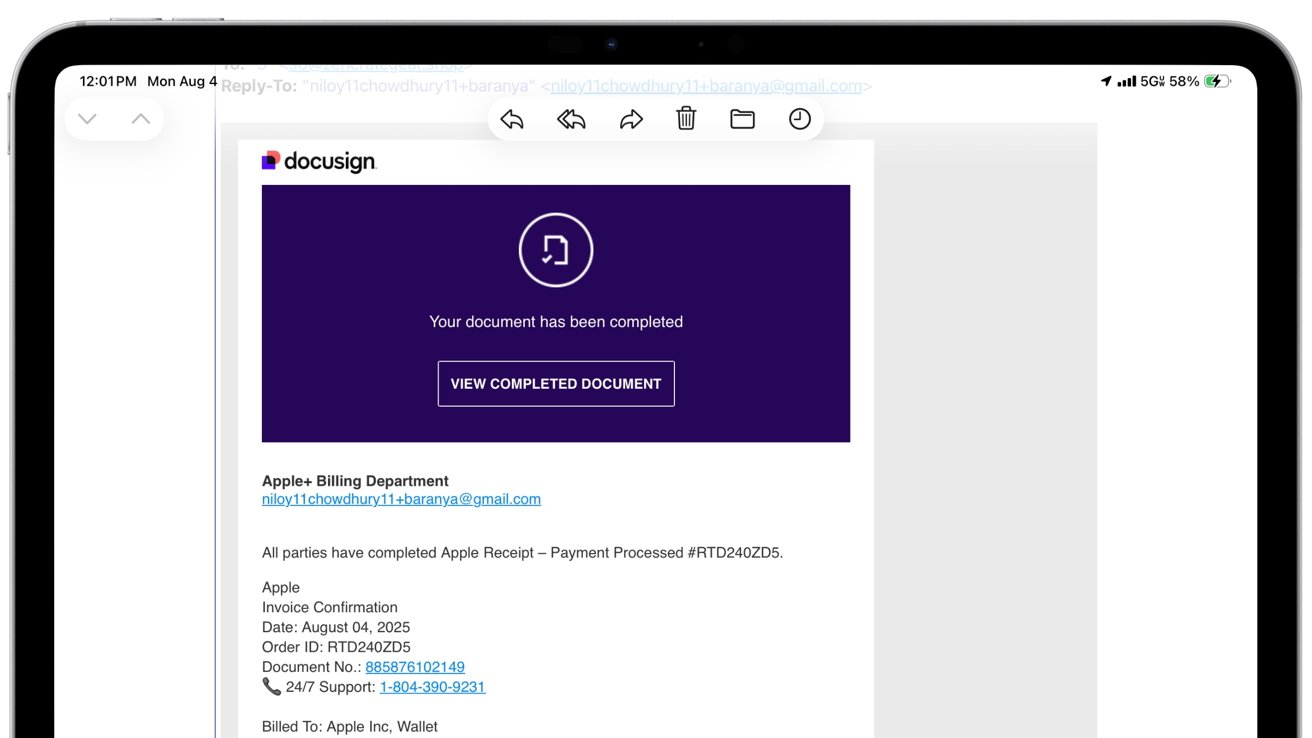
Fake Apple email from scammers
Just about everybody on the AppleInsider staff is receiving messages that look like billing receipts for recent Apple Pay purchases. The email claims a subscription has been charged to your account and includes a phone number to call if it wasn't you.
Don't call it. Don't click on anything.
That number doesn't go to Apple. It connects you to scammers posing as support agents.
This message in particuilar uses Apple's branding and is framed as a DocuSign alert. It includes a fake order ID, a charge total, and language meant to create urgency. The entire setup is designed to get you to react quickly and call.
In other examples, the charge is often for something recognizable, like a Netflix subscription. But, almost always, the emails say that the payment went through Apple Pay and that a document is ready to view on DocuSign.
The email may include a security code to "access" the file, which helps make it look more official. That alone is a red flag, and another is the support number. In about six examples we've seen spanning several different services, scammers used 1-804-390-9231.
The sender name may also contain odd characters, like a Cyrillic "B" in "Billing," to evade spam filters and make the email harder to block.How the scam works
Calling the number connects you to someone pretending to be Apple Support. Or, it could be from whatever company whose product you use.
We've seen so many of these. We've gotten phishing emails from Netflix, Apple, a lawn service company, Expedia, and so many more. They may say your account was compromised or that the charge needs to be reversed.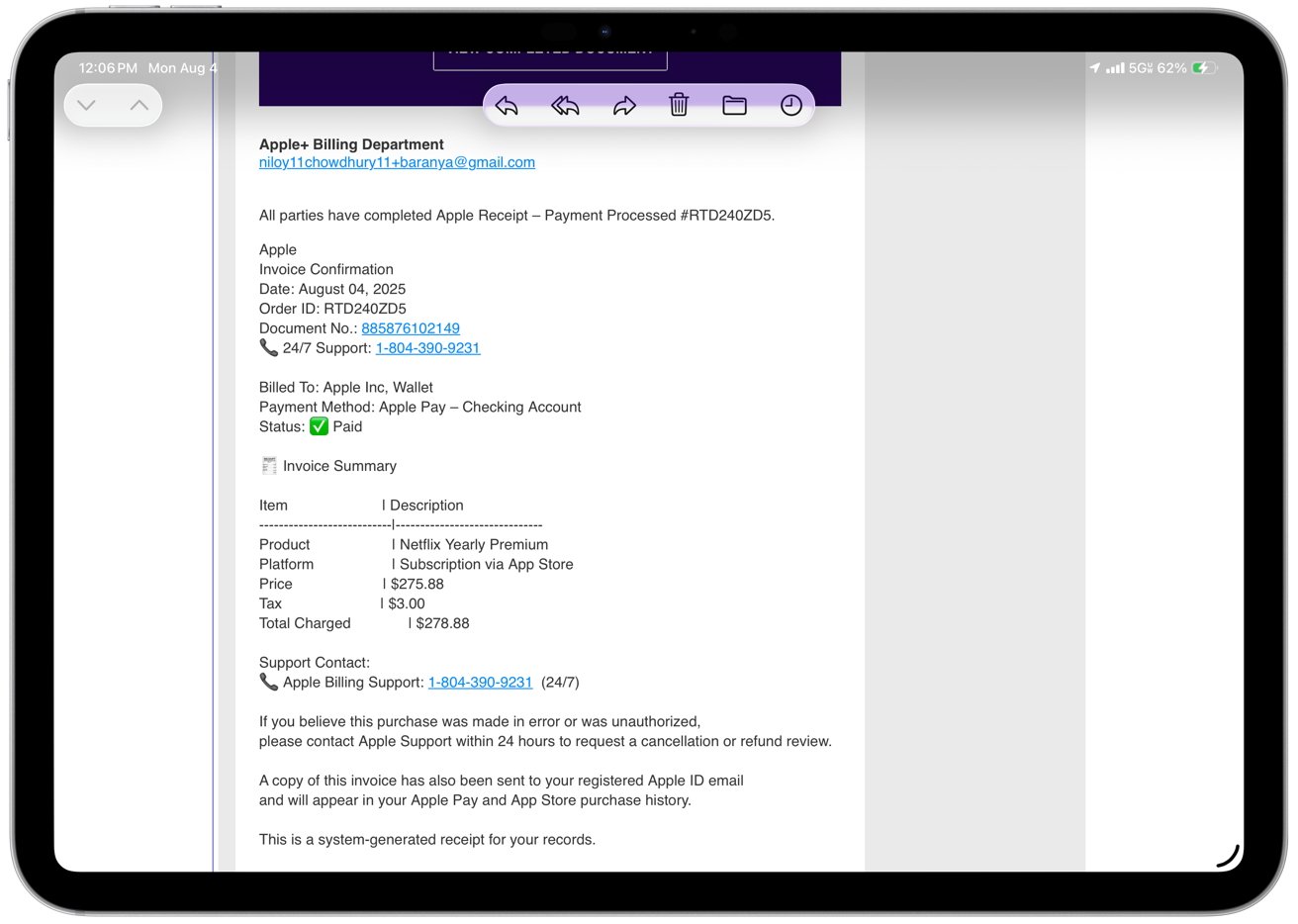
The fake receipt from the scammers
From there, they might ask for personal details, passwords, or remote access to your device. Some demand payment to "secure" your account.
Once they gain access, they can lock you out, steal information, or initiate fraudulent transactions. You can often spot the scam by checking a few key details.- The sender isn't from an official company domain.
- The receipt is delivered through DocuSign, which Apple, Netflix and others, don't use.
- The message creates artificial urgency to push you into calling.
- The support number isn't listed on the company's website.
- The charge doesn't show up in your App Store or Wallet history.
Legitimate billing emails won't ask you to call a phone number. If something seems off, log into your Apple ID and check recent transactions in the Settings app on your devices.Tips to avoid support scams in 2025
If you get one of these emails, don't click anything or call the number. Delete the message and report it.
To report Apple-related scams, forward the email to reportphishing@apple.com. If the message came through DocuSign, send it to spam@docusign.com.
To verify any real charges, open the App Store or Wallet app on your device. You can also check your account directly at support.apple.com.
Scammers often target Apple users because of the trust built around Apple services and branding. Combining that with DocuSign, which is commonly used for secure documents, makes the scam more believable.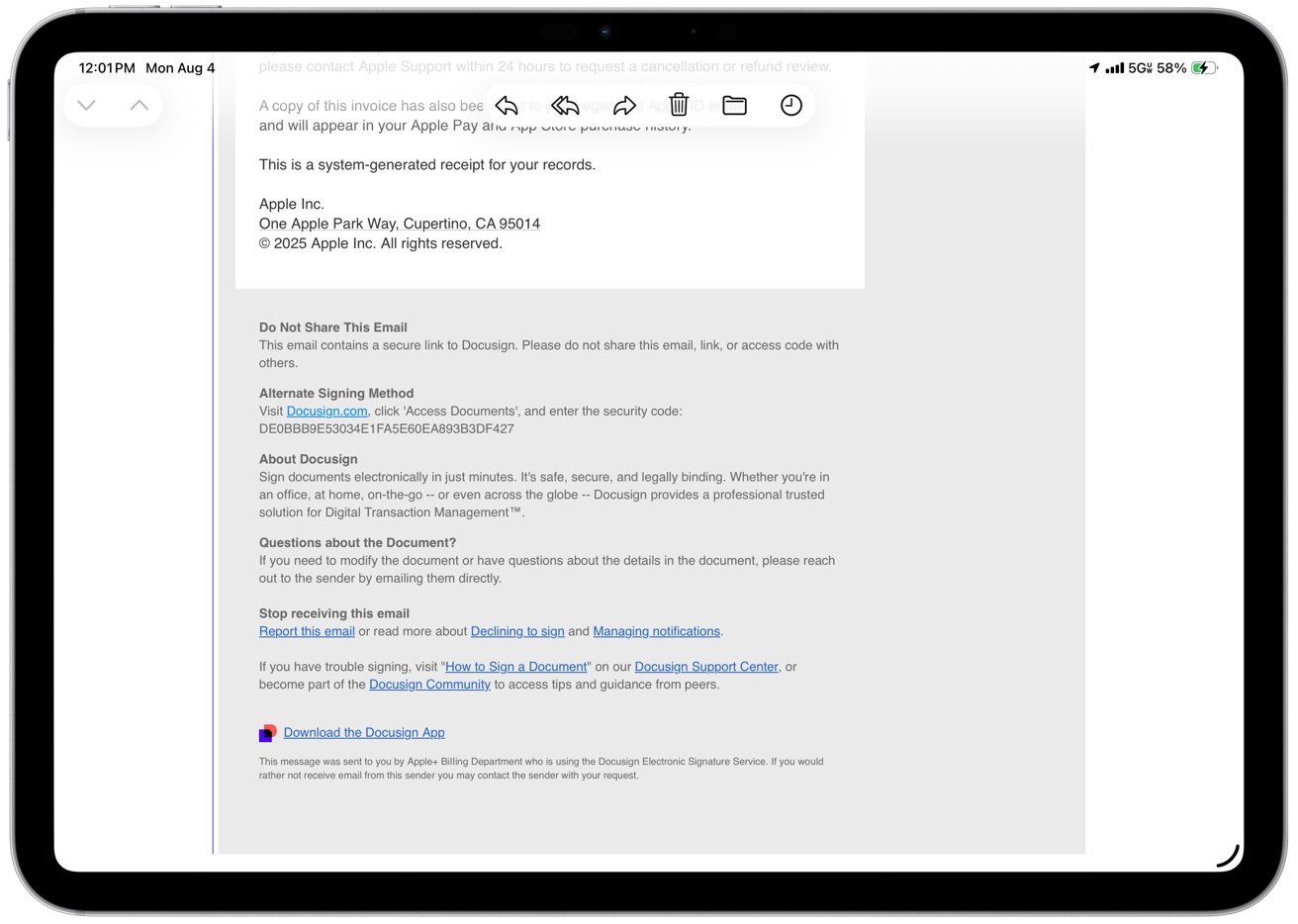
These scammers impersonate many companies
These attacks aren't limited to Apple. Scammers regularly use DocuSign to impersonate other trusted companies, including banks, insurance providers, and delivery services. They may send fake invoices, legal documents, and other statements meant to look like official communications.
The DocuSign brand creates a false sense of security. It helps the email get past spam filters and makes recipients more likely to open it. Even when the company name changes, the strategy is the same.
Scammers want you to click, call, or enter sensitive information so they can take control of your account.
If you're ever unsure about a message, skip the link and go directly to the company's official website. A quick pause can make the difference between staying safe and getting scammed.
Read on AppleInsider
-
Apple Cinemas may come to regret their name as lawyers step in
Apple has filed a lawsuit against the movie theater Apple Cinemas over what it says is a deliberate attempt to capitalize on its name.
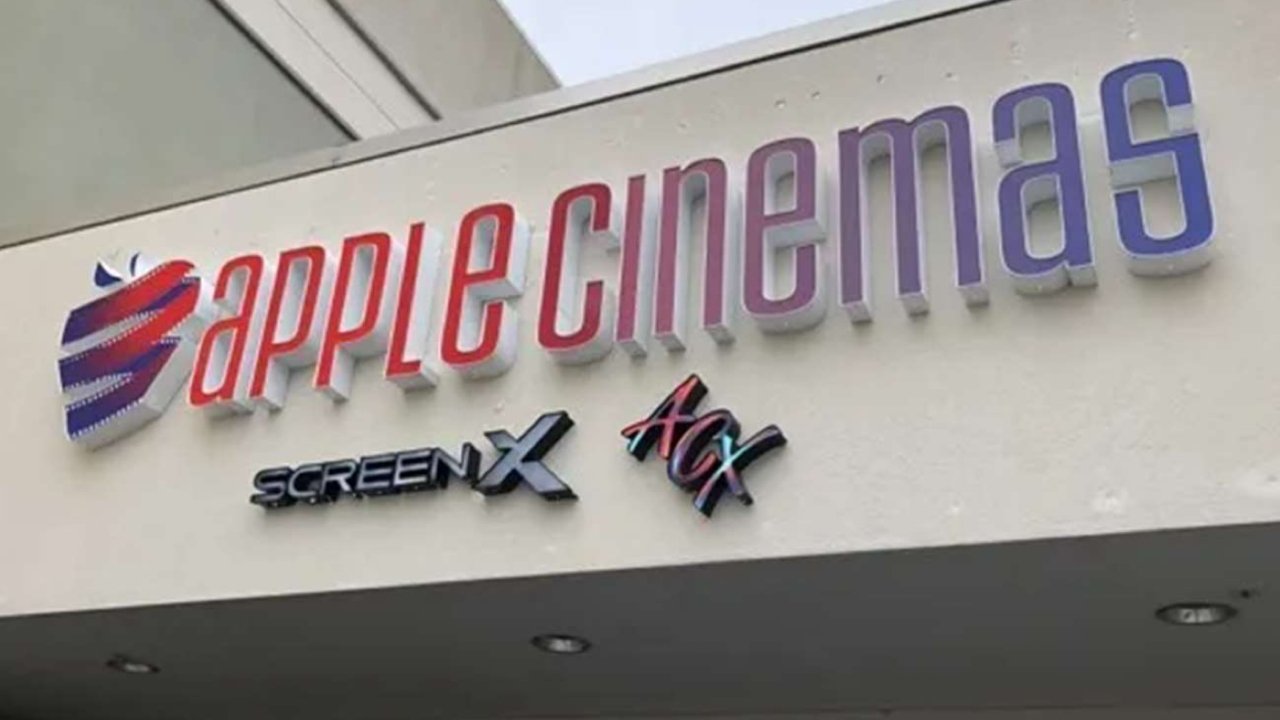
An Apple Cinema displaying the company's logo -- image credit; Apple
It's not usually a surprise when a corporation sues to protect its name or trademarks, and usually it's more unexpected when they fail. But Apple Cinemas opened its first theater in 2013, and it was founded in 2010, yet Apple seemingly left it alone until now.
That's because up until recently, Apple Cinemas was a small chain based in Massachusetts. But in the course of an initially quite slow expansion, it opened a theater in San Fransisco in July 2025, and apparently that was too close to home for Apple.
As first spotted by MacRumors, Apple has filed suit because Apple Cinemas has announced plans to add 100 further theaters nationwide. According to Apple's full filing, the movie company has "refused to engage with Apple's repeated efforts to resolve the matter amicably."
More, Apple alleges that there is already public confusion over its involvement in the chain, and cites social media posts as evidence. Plus it claims that Apple Cinemas marked the opening of its San Francisco theater by touting "its 'high-tech' offerings'," as it "teased another San Francisco Bay Area theater coming soon."
Apple maintains that these two theaters are close to its Apple Park headquarters, and claims that Apple Cinemas is intentionally pursuing nationwide expansion near Apple's retail store locations.
Reportedly, the owners of the chain applied to the US Patent and Trademark Office (USPTO) in 2024 to register "Apple Cinemas" and "ACX -- Apple Cinematic Experience". Both applications were denied, specifically because USPTO said they were likely to cause confusion with Apple's prior trademarks.
Apple subsequently sent a cease and desist letter to the chain's owners, Sand Media. The owners have not commented publicly.
There are multiple businesses whose names include the word "Apple." However, this movie theater chain is expanding just Apple is seeing success with films such as "F1: The Movie," and as the filing points out, also had success with an Apple Cinema Display.
According to Apple Cinema listings, the theater chain is currently screening Apple's "F1: The Movie" movie on its new San Fransisco screen, called Apple Cinemas Van Ness Imax. Ticket prices are $18.75 for an adult's regular seat, $16.75 for seniors and children.
Read on AppleInsider
-
Fears over tariff price rises prompted panic buying of iPhones
Prior to the earnings conference call, Tim Cook said that Apple saw users buying devices such as the iPhone outside of normal expectations because of concerns that tariffs would force prices to rise.

Tim Cook and Donald Trump in a meeting at the White House in 2018
During Apple's previous earnings call in May 2025, Tim Cook said that there had been some iPhone panic buying ahead of Trump's "reciprocal" tariffs, but that it had not been significant. Now as the company announces its results for the first quarter when the tariffs were in place, the situation has changed.
"On the buying ahead relative to worrying about prices and so forth on tariffs, we did see some evidence of that in the early part of the quarter," Cook told CNBC. "We would estimate it to be about one point of the 10 points of company growth."
He previously said that the tariff impact on Apple during March had been limited because of how the company reorganized its supply and delivery chains. But he noted that at that point, Apple was estimating that tariff cost increases would "add $900 million to our costs."
The wide-ranging, and ever-changing, tariffs are needless, and damaging despite Trump's claims that they are tiny, and that anyway other countries pay them. They do not, it is US companies that pay, and therefore US consumers too, but Apple had been predicted to minimize the impact on buyers for this quarter.
For subsequent quarters, Tim Cook has previously refused to issue guidance because there have been simply too many unknown factors. However, with the new iPhone 17 range launching in September, Apple may have to raise prices.Mitigating against tariff costs
Cook did also qualify that the "bulk of the tariffs that we paid were the IEEPA tariffs that hit early in the year related to China." IEEPA is the term for Trump's "reciprocal" tariffs, and they vary from country to country, but the highest fees are applied to imports from China.
Apple has minimized this tariff impact by altering how products are distributed. Cook said that the majority of iPhones sold in the US are made in India.
"And the vast majority of other products -- the Mac, and the iPad, and the Apple Watch -- [sold in the US] have a country of origin of Vietnam," he continued. "Still, the products for other international countries, the vast majority of them are coming from China."
Despite the reorganization to source US devices from countries with the lowest tariffs, the situation is not stable. Most recently Trump was reported to be imposing a 25% tariff on goods imported from India -- which means Apple paying eight times as much in import fees as before.
Read on AppleInsider
-
Doom and gloom reporting on Apple Intelligence continues to ignore Apple's playbook
Chances are you've been underwhelmed by Apple Intelligence, but a combination of unrealistic expectations, fictional narratives, and ignored progress won't stop it from being a key part of Apple's ecosystem.
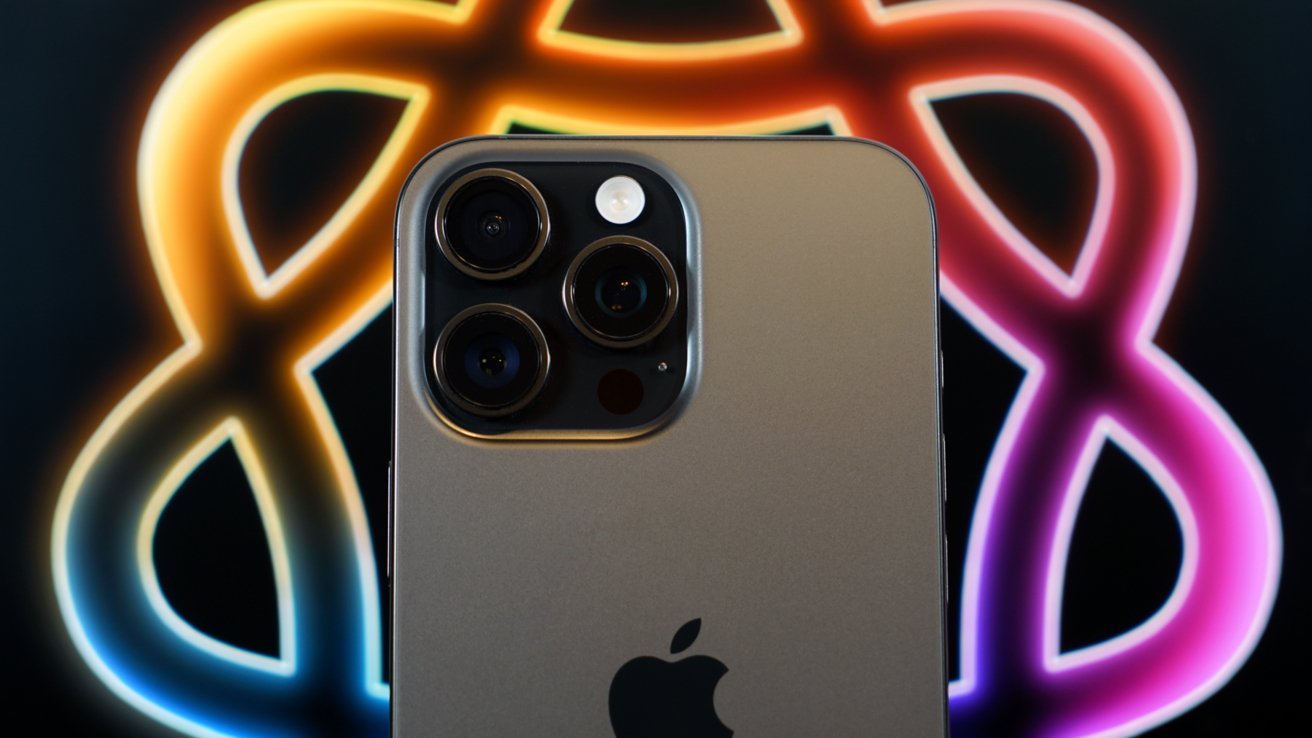
Apple Intelligence isn't chasing the same AI grift as other companies
The world viewed WWDC 2024 with middling expectations for Apple's late entry into the artificial intelligence race. The slow rollout and limited functions caused an expected yawn from analysts that were used to the grift and glamour promised by other tech companies, and that should be expected by now.
The protracted exhale of doom and gloom reporting continues with a ranging history and speculation on Apple's AI initiatives from The Information. Much of the information has been previously covered by Bloomberg, but it did detail the history of Apple's foundation model team.
However, my focus is on the expected narrative around Apple's supposed internal confusion around AI and its strategy (or lack thereof) resulting in discontent and staff departures. As always, it's important to remember that "people familiar with the matter" are likely disgruntled employees excited to speak about their pet peeves, and the coverage will likely lean into any negative narratives that help amplify a story.
The reality is the artificial intelligence industry is large, complex, and full of momentum that results in more flux and noise than even Apple is used to dealing with. It would be impossible to ignore the allure of working on what is promised to be the future of AI, superintelligence, with a giant pay package larger than Apple's CEO.Apple's true AI problem
The issue isn't that Apple got caught off guard or has some kind of talent brain drain. It's the usual problem with Apple that the world has with the company -- its pursuit of consumer privacy and maintaining product plan secrecy.
Both of these facets are polar opposites of the AI mantra that requires being loud, declaring the end of civilization with every point update, and sucking up every ounce of data available, legal or not. That said, Apple's offerings are very different from what we've seen from other AI companies and certainly come off as underwhelming compared to seemingly sentient AI chatbots.
There's no good way to make advanced autocorrect sound interesting. Apple Intelligence launched with Writing Tools that edit, manipulate, or generate text, Image Playground with poorly made renderings of people and emoji, and notification summaries that caught a lot of flack from news publications.
On the range between Apple's worst launch, Apple Maps, and iPhone, it's closer to Apple Maps on the spectrum. However, it's not the absolute disaster being peddled by many reports on the technology.
For the most part, people outside of the tech space likely have some idea what artificial intelligence is and have no idea that Apple even has a version running on their iPhone. Apple's strategy in the space is to get out of the way and offer the technology in ways that enhance the user experience without always shouting that it is an AI feature.
The most you'll see of Apple indicating Apple Intelligence is in use is the shiny rainbow elements that show up in the UI. A lot of Apple Intelligence isn't even explained beyond a tiny symbol in a summary, if a sign of AI is shown at all.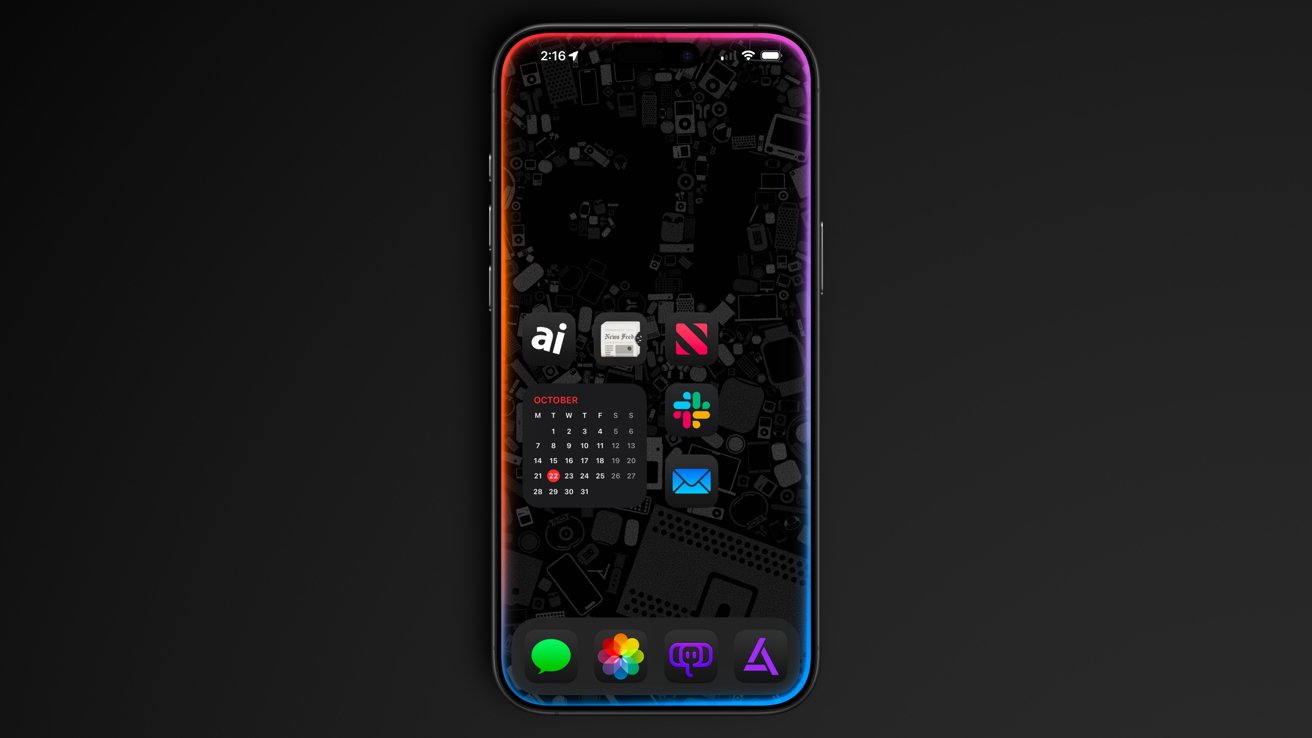
The Siri animation is the most prominent use of Apple's AI rainbow
Apple's strategy going forward, offering developers and users direct access to the foundation models, is to get further out of the way. There will be times Apple Intelligence is in use that the user will never even realize -- and that's the point.
Which is the perceived problem with Apple Intelligence. It isn't here to allegedly replace jobs or discover "new" physics, but it is here to improve workflows and help users with mundane tasks.AI reporting's red herrings
One of the biggest misses that has been repeated around Apple Intelligence since its launch is the idea of Apple being behind or caught off guard by AI. Rewind to before ChatGPT's debut, and Apple was at the forefront of machine learning and was even offering Neural Engines in all of its products before it was an industry standard.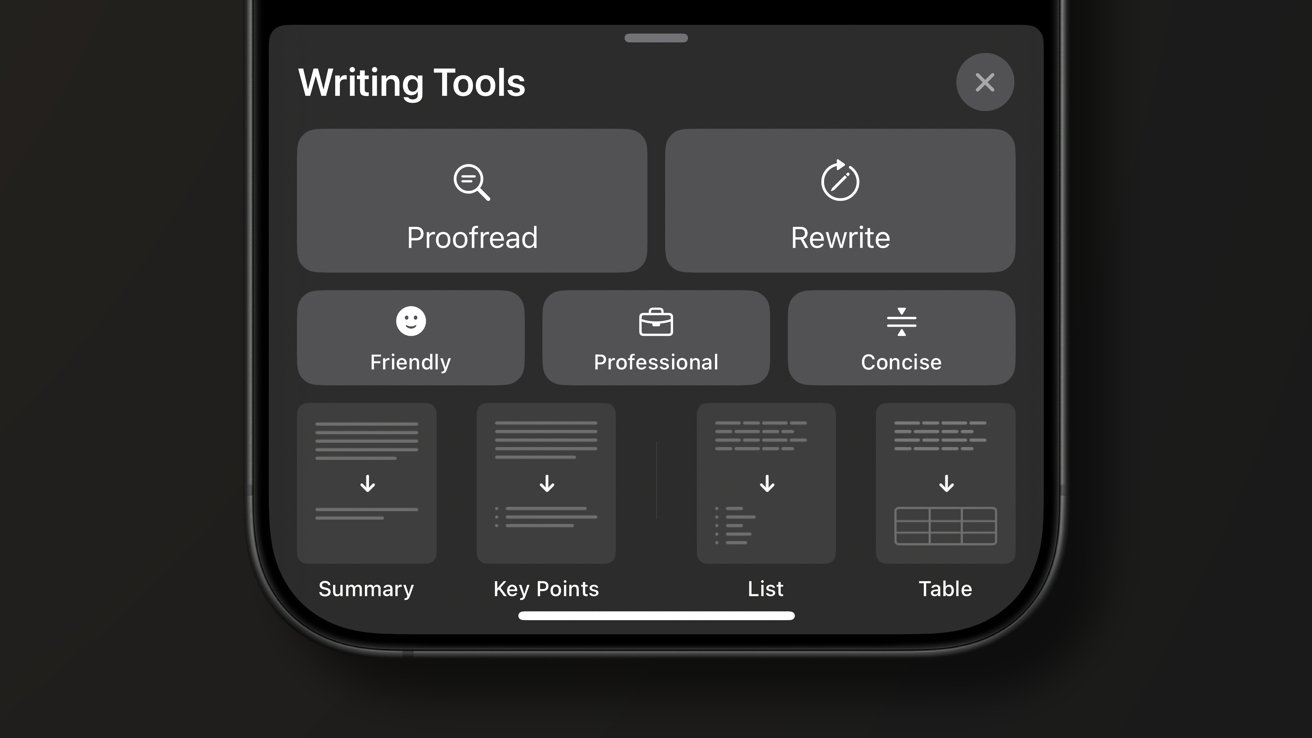
Apple Intelligence was built on Apple's strong foundation of ML
Once the industry learned that the catch-all term of "artificial intelligence" was being used everywhere, even in place of the more accurate machine learning term, demand for that term skyrocketed. Instead of misleading customers, Apple continued referring to its machine learning tools as such, and waited to call anything AI until it was using generative technologies.
The report suggests that Giannandrea was so disconnected from the idea that LLMs could be useful that he stopped Apple from pursuing them in 2022 when Ruoming Pang, the now-departed head of Apple's foundation model team, introduced them. That narrative is likely accurate, but it leaves out the fact that LLMs were largely useless in their debut state as incredibly hallucinatory chatbots.
The story around Apple Intelligence continues to suggest that Apple's executive team woke up sometime in 2023 and realized the technology was important and should be pursued. However, this very same report suggests that Apple's teams under Giannandrea had been working on various AI technologies since they were put together in 2018.
The reality is much more simple -- analysts and pundits are unhappy with how Apple has approached AI so far. They seem to have completely missed what Apple's strategy is and continue to push the idea Apple is behind instead of considering the company's own direction.
Of course, I won't ignore that there has been some reshuffling of leadership internally as Apple has adjusted how it wants to tackle AI. Craig Federighi is now overseeing Apple's AI initiatives, and the company is looking externally to bolster its efforts.
However, instead of celebrating Apple's ability to develop both its internal models while seeking to give customers options, reports suggest Apple is giving up on its own efforts. There don't appear to be any signs of that actually occurring beyond these reports from anonymous employees.Apple's true AI goals
For some reason, everyone seems completely ready to accept that Apple is just going to hire OpenAI or Anthropic to build the backend of Siri while alienating its own teams. This incredible departure from Apple's usual strategy of vertical integration has just been accepted as expected because, given the narrative around how behind Apple is, the company would have no other choice but to give up.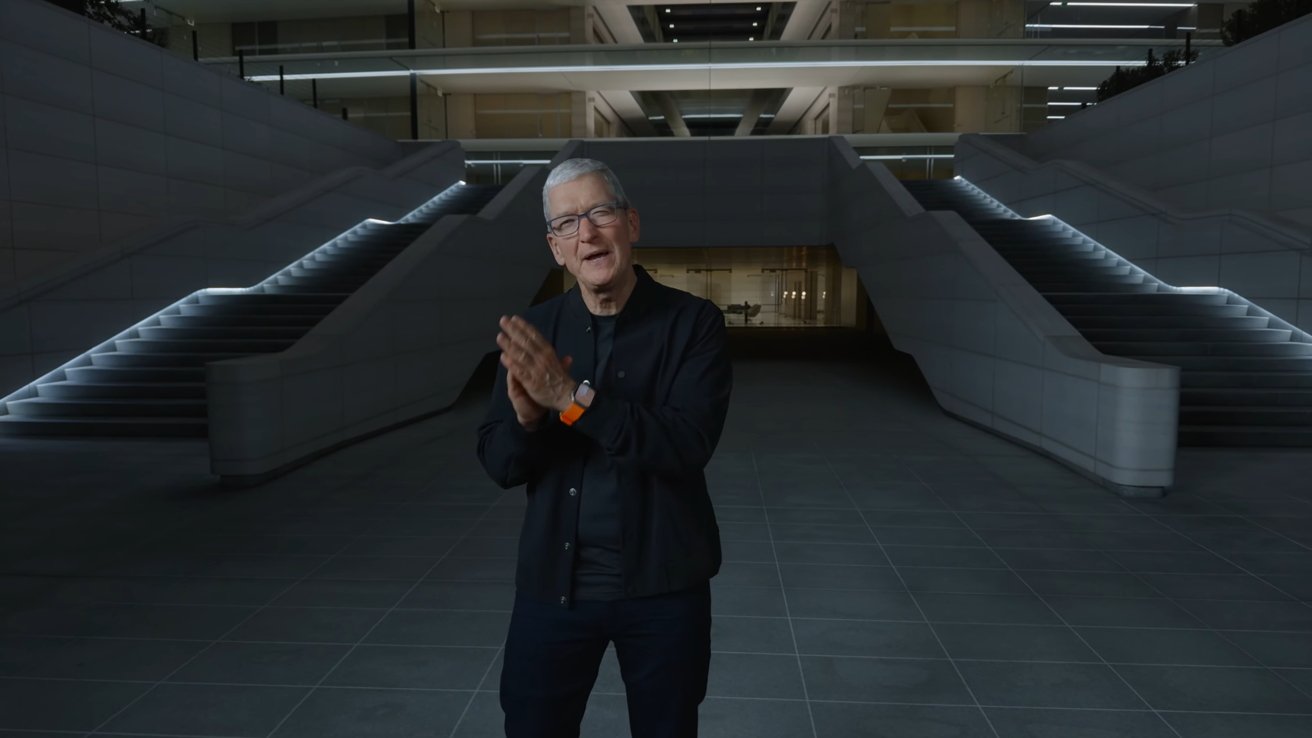
Apple CEO Tim Cook isn't sleeping on Apple Intelligence. Image source: Apple
Instead, when framed from a company that knows what it is doing and is actively evolving its strategy to play in the consistently exaggerated AI field, it's easy to see where Apple may be going with Apple Intelligence. It starts with app intents and ends with a private AI ecosystem.
Apple's executive team likely stepped in and surprised the Apple Intelligence team with its announcement of the contextual AI and Siri delay. The report reveals what I've suspected all along -- that Apple had a working version ready to ship, but the failure rate was below Apple's incredible standards.
The primary example Apple showed off with the new contextual Siri that relies on app intents is the mom at the airport scenario. Imagine if there was a 30% chance that it told you the wrong time, or even the wrong airport or wrong day.
If poorly summarized headlines made the news, wait and see what would happen if one person out of billions of users goes to the wrong airport.
Apple's pursuit of perfection with AI is likely a folly since the technology is inherently failure-prone. It can't think or reason, so unless there are some incredible checks and balances with human intervention, there likely will never be a 100% guarantee of accuracy.
Whatever system Apple devises to help overcome this limitation of AI, it'll likely debut later in 2025 or early 2026 during the iOS 26 cycle. I have no doubt that a version of that technology is coming, even as Apple further utilizes app intents in other ways across its platforms.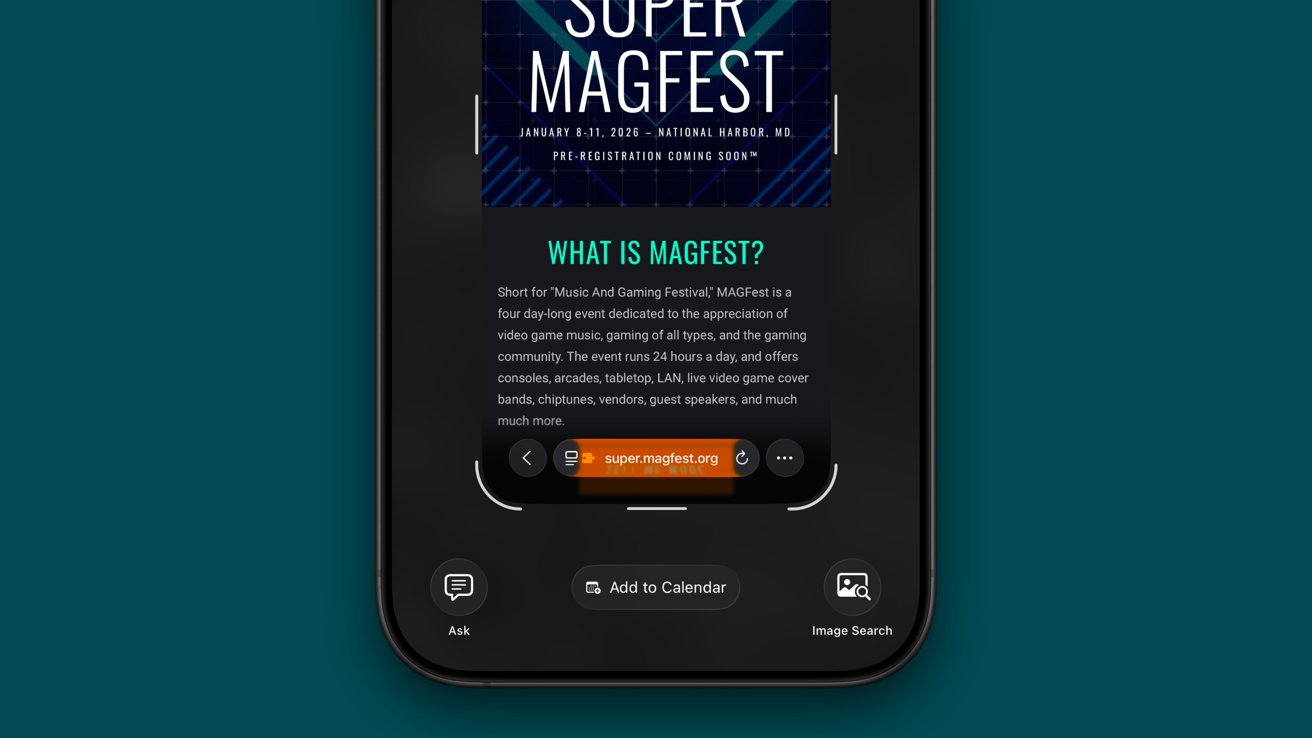
Apple is already brining third-party tools into the Apple Intelligence umbrella
Where the contextual, on-device, and private Apple Intelligence will be game-changing on its own, it's nothing compared to what could come next. Apple's willingness to develop its models while still giving users access to others will be its ultimate victory in the space.
I don't believe Apple is going to replace the Siri backend with Claude or ChatGPT. That reporting seems to be the result of pundit wishcasting and the desire to see Apple fail.
Instead, Apple seems to be in talks with OpenAI, Anthropic, and others to bring models of their popular AI programs to Private Cloud Compute. If that happens, it goes well beyond Siri simply shaking hands with ChatGPT over a privacy-preserving connection -- it guarantees user data will never be used by third parties.
If Apple's pitch for Private Cloud Compute is a server-side AI that runs with the same privacy and security measures as an on-device AI, then imagine those same conditions applying to ChatGPT.
The future of Apple Intelligence is a combination of contextually aware local models running on devices with access to third-party models running via Private Cloud Compute. Users would be able to choose which models suit their needs in the moment and submit data without fear of it becoming part of training data.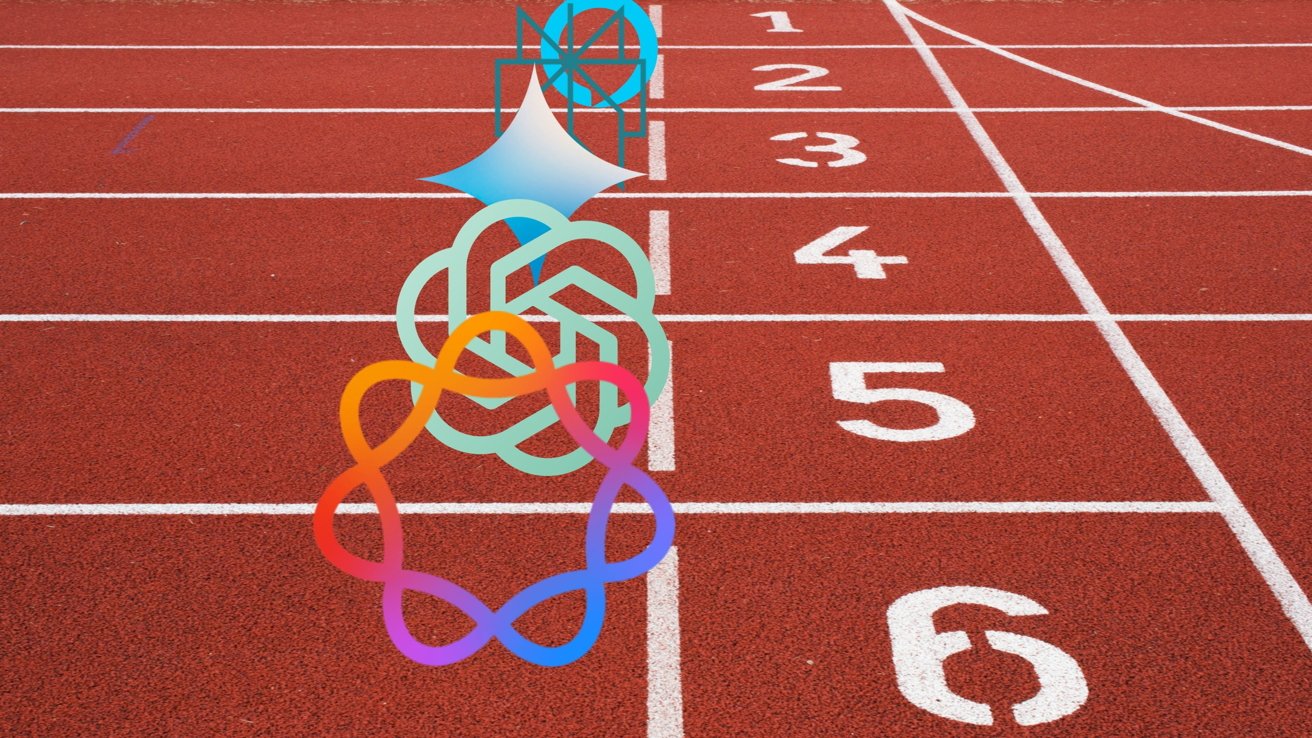
Apple could win the race by giving users choice in an AI ecosystem
The Apple Intelligence ecosystem would be the only one built from the ground up for ethical artificial intelligence. Regardless of model, on device or in Apple's servers, it would run privately, securely, and on renewable energy.
In a world filled with exaggerations around AI and its future, we should celebrate the grounded and realistic promises. Artificial intelligence is a tool, like a hammer, that can enhance human productivity, not replace it, and Apple's strategy reflects that.
Apple's tagline for Apple Intelligence is "AI for the rest of us." And by providing billions of Apple customers access to sustainable, ethical, private, and secure AI models, I'd argue Apple is pursuing a potential future that's not only realistic, but places it well ahead of the competition.
Read on AppleInsider


-
TSMC US chip production may soon only be three years behind Taiwan
TSMC is working to build two plants in Arizona faster, a move that could bring more Apple chip production to Arizona quicker -- but don't expect the newest chips.

A worker passing a TSMC sign
The TSMC facility in Phoenix, known as Fab 21, is the chip foundry's first factory in Arizona dedicated to chip production. However, while two others are under construction, TSMC plans to have them up and running sooner than first thought.
According to Nikkei, TSMC intends to speed up construction of the two sites considerably. The factories will be accelerated "by several quarters," TSMC claims, with the intention of bringing them online faster.
TSMC says it is to meet the demand from U.S.-based customers for smartphone and AI computing chips.
"After completion, around 30% of our 2-nanometer and more advanced [chip] capacity will be located in Arizona," said TSMC chairman and CEO CC Wei on Thursday. It will create "an independent, leading-edge semiconductor manufacturing cluster in the U.S."Closer to Taiwan tech
The assertion by TSMC that it will be cutting "several quarters" off the construction time for its two factories is a big thing for U.S. chip production in general. Something that is severely lagging behind Taiwan.
In March, it was said that the second Arizona plant would be ready for 3-nanometer chip production by 2028, while the third plant would be used for 2-nanometer chips. That third plant, which broke ground in April 2025, was thought to be ready by 2030.
With 2-nanometer production already in progress in TSMC's Taiwan facilities, that effectively meant that TSMC's U.S. facilities were five years behind Taiwan.
By cutting down the construction schedule by a considerable amount, this could bring the overall lag for U.S. production down to as few as three years.Faster by investment
The acceleration of construction follows months after TSMC pledged a $100 billion investment in the United States. The investment, intended to take place over four years, was to be used to increase TSMC's manufacturing footprint in the country.
TSMC had already made an initial investment in Arizona to the tune of $12 billion in 2020. It has also received a $6.6 billion package from the Biden administration as part of the CHIPS act.
The latest high-value pledge will almost certainly be used in part to speed up the building of the facilities. Processes which, due to the size and complexity, take a long time to complete.The U.S. iPhone chip dream
The acceleration of construction at the facilities should be well received by the administration of President Donald Trump. He has repeatedly campaigned for more manufacturing to return to the United States, and has called out Apple to do the same.
There are roadblocks. Notably, a lack of U.S.-based resources and an educated local workforce needed for iPhone assembly to take place at all are the main hindrances.
It is highly plausible that the smartphone and AI chip demand could be from Apple, as the Cupertino company is one of TSMC's biggest chip clients. Such a move will make the construction of an iPhone entirely in the United States a little bit closer to reality.
Until that happens, Apple has no choice but to accept that its chips have to be built in TSMC's more up-to-date facilities in Taiwan. At least, for its more advanced chips.
The $100 billion won't necessarily allow the U.S. projects to catch up to Taiwan completely, but a few quarters closer is still a lot when it comes to manufacturing.
Read on AppleInsider

